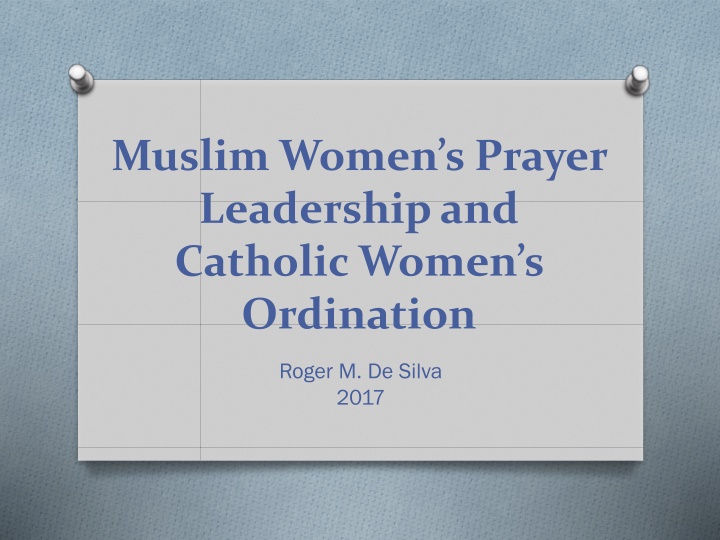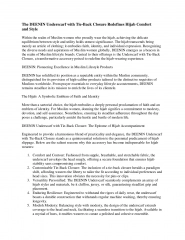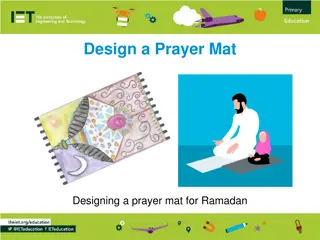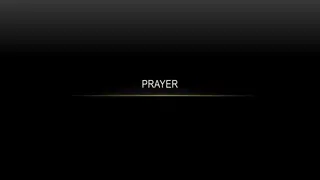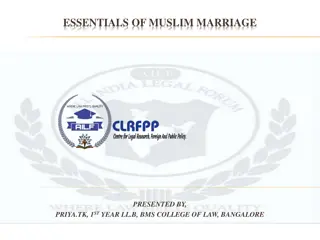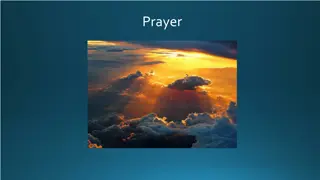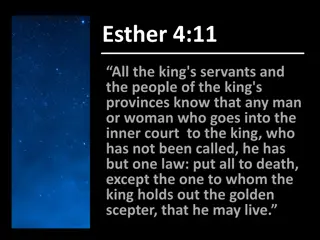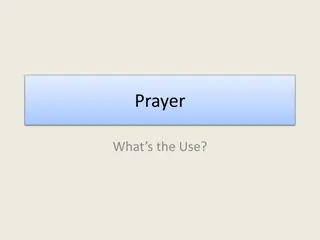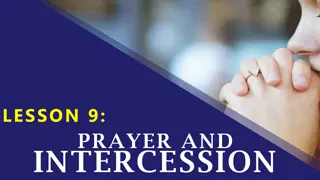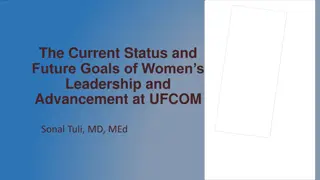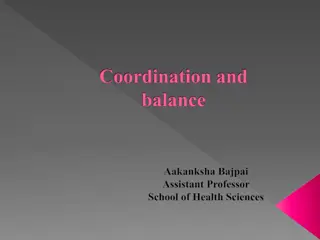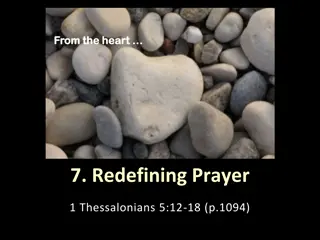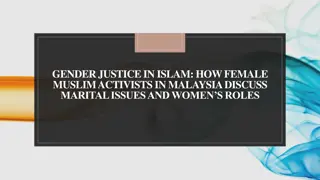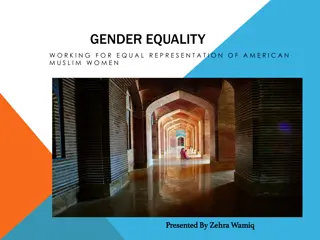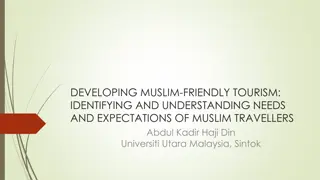Women's Leadership in Muslim Prayer and Catholic Ordination
Explore the intersection of women's leadership in prayer within Islam and the ordination of women in the Catholic Church. Delve into the teachings, debates, and perspectives regarding women's roles in religious leadership, examining Islamic practices, Catholic canons, and theological reflections on women's ordination.
Download Presentation

Please find below an Image/Link to download the presentation.
The content on the website is provided AS IS for your information and personal use only. It may not be sold, licensed, or shared on other websites without obtaining consent from the author.If you encounter any issues during the download, it is possible that the publisher has removed the file from their server.
You are allowed to download the files provided on this website for personal or commercial use, subject to the condition that they are used lawfully. All files are the property of their respective owners.
The content on the website is provided AS IS for your information and personal use only. It may not be sold, licensed, or shared on other websites without obtaining consent from the author.
E N D
Presentation Transcript
Muslim Womens Prayer Leadership and Catholic Women s Ordination Roger M. De Silva 2017
Where have they been? Where are they going? O By this time the students have already learned the basics of Islam. Topics include the Qur an, the Prophet Muhammad, the Five Pillars of Islamic Practice and Five Pillars of Faith (iman), the Sunnah, hadith, sharia, and fiqh. O Students have also studied the Catholic Church s teaching on Canon Law and how it is used. O We would have just finished Mark Matthews lesson plan on Sharia and the U.S. Constitution, available through this website. O This lesson will enable students to view how sharia and canon law are used by both religions regarding issues of ethics, correct behavior in life, morality, religious obligations and one s spiritual life, as seen discussed in the issues of women in leadership roles in prayer or serving as priests in their respective religions.
TWO READINGS REGARDING WOMEN- LED PRAYER IN ISLAM O Imam Zaid Shakir, An Examination of the Issue of Female Prayer Leadership, March 23, 200http://lamppostproductions.com/wp- content/uploads/files/articles/female%20imam-3.pdf O Laury Silvers, Islamic Jurisprudence, Civil Disobedience, and Woman-Led Prayer, April 18, 2005 http://www.patheos.com/blogs/altmuslim/2005/05 islamic_jurisprudence_civil_disobedience_and_woman_led_prayer/
Statement on womens ordination O Students are then asked to view the statement on Women s Ordination. O This statement demonstrates how the Catholic Church uses Scripture and Tradition in forming canon law. O http://www.usccb.org/beliefs-and-teachings/ecumenical-and- interreligious/ecumenical/anglican/ordination-women.cfm O The ARC Anglican Roman Consultation 1975 O Essential Tradition O Scriptures O Ecumenical Creeds O Church s Liturgical Tradition O Proclamation and Teaching O The relation of human beings to the God and Father of our Lord Jesus Christ
O Womens ordination raises issues which cannot be answered adequately by the mere citing of traditional practices and beliefs. O Model: Jesus chose only men to be apostles O Because it has been done this way for so long it holds a weighty precedent. O Does it hold for all time or is it capable of change when cultural evolution presents new possibilities for witness to the gospel? O Because women are now seen as leaders in many roles in the Church, might they not be ordained? O If there are no strong reasons against it what are the strong reasons for it? O Adequate theological reflection is necessary.
Priesthood: A Feminist Perspective O Can Women become Priests? : A Catholic Feminist Perspective Susan A. Ross O http://digitalcommons.butler.edu/cgi/viewcontent.cgi?article=1338&context=jh cs Can Women become priests? It depends on who you ask. It depends on who you ask.
Very quick and incomplete overview In the early Church but before 5thC.: Church was in the home and it seemed women had roles but it is not clear what those roles were. O 5thC. Women were not included in the class of leaders of the Church and did not preside at Eucharist. O There is clear evidence women were ordained to various ministries in the medieval Church (deaconesses, abbesses, and canonesses) which had liturgical implication. O 13thC. The connection of orders with sacramental ministry was established. O Late 13thC. Thomas Aquinas considered the issue and concluded women could not receive the Sacrament of Holy Orders since they lacked eminence and degree . The short of it they were ontologically inferior. O 1975: First R.C Women s Ordination Conference in Detroit. Prominent Theologians and Bishops argued in favor of women s ordination. O Bottom Line: 1994 The Vatican issued Ordinatio Sacerdotalis which stated the issue on women s ordination was resolved and the Church s official position should be considered part of the ordinary magisterium O Can women be ordained priests? If the traditional Catholic priesthood is maintained then the answer is clearly no . O
Step 1: Assign Readings and tasks Group Group P P: : Imam Zaid Shakir, An Examination of the Issue of Female Prayer Leadership O Read the article by Imam Zaid Shakir. Make a list of the reasons he gives as to why women should not lead prayer. O Group Group R R: : Laury Silvers, Islamic Jurisprudence, Civil Disobedience, and Woman-Led Prayer O Read the article by Laury Silvers. Make a list of the reasons she gives as to why women should lead prayer. O Group Group A: : USCCB, State on the Ordination of Women O Read the article by the USCCB. Make a list of the reasons they give against the ordination of women. O Group Group Y Y: : Susan A. Ross , Can Women become Priests? : A Catholic Feminist Perspective O Read the article by Susan A Ross. Make a list of the reasons she gives for the ordination of women. O
Step 2: Small group discussion /collaboration O Students will meet in their assigned groups to discuss the lists they created from their reading. From this they will need to come up with one list. They will also discuss from where, if it may be determined, did their author get their supporting arguments. Was it from the Qur an, the Bible, the Hadith, other scholars, and other sources? They should write this information next to the reasons from their authors. (Students will write their responses on large sheets of paper that will be put up on the walls for further discussion).
Step 3: Class Discussion O This information will be discussed in the large group. Teacher may have to clarify some of the information for the students. At this point students may wish to argue who is right and who is wrong. Do not let this happen. It is not about right or wrong, winning or losing; rather, it is about gathering information and understanding the source of the reasoning behind the statements.
Step 4: Comparing the discussions of the two religions O Students will now be placed in groups made up of members of Group P P and Group A A as one group and Group R R and group Y as another group. Then divide those groups so that there are an even number (or close to it) of Ps Ps and As As in two groups (or more, depending on the size of the class) and the same of R R and Y Y. O The students are to then discuss the similarities and differences they found in the ideas put forth by the Muslim and Catholic authors they read.
Step 5: Final discussion and closure O The students will come back as a class to discuss what they discovered to be the similarities and differences they discovered. They will be asked: Why they think there are those similarities? What are the sources of the similarities? How do they feel about discovering these similarities and differences. Did it change anything they thought about Muslims and Catholics? The teacher can bring the students back to the understanding that both religious communities do not make decisions based solely on their scriptures. They will look at the other sources that the students may have discovered from their readings.
Some resources for the teacher on Sharia O Those defending US Constitution from sharia must have failed high school civics. http://www.defendingreligiousfreedom.com/those-defending-us-constitution-from-sharia-must-have-failed-high-school-civics/ Want Want to argue about sharia ? Here s what it to argue about sharia ? Here s what it means. Audio interview and script by Kim Malcolm and Gil Aegerter with Asifa Quarishi-Landes, law prefessor at the University of Wisconsin June 9, 2017 KUOW Sound Stories. Sound Voices O http-//kuow.org/post/wan#D3552A means. O ING EDUCATION FOR CULTURAL LITERACY AND MUTUAL RESPECT O https://ing.org/a-closer-look-at-sharia-in-the-united-states/ A CLOSER LOOK AT SHARIA IN THE UNITED STATES
Some resources for the teacher on Canon Law O Canon is the Greek word for rule, norm, standard or measure. It is used in several ways in church language http://www.usccb.org/beliefs-and-teachings/what-we-believe/canon-law/index.cfm O What is the Meaning of the Term canon law https://youtu.be/6pVJcekdMkc
